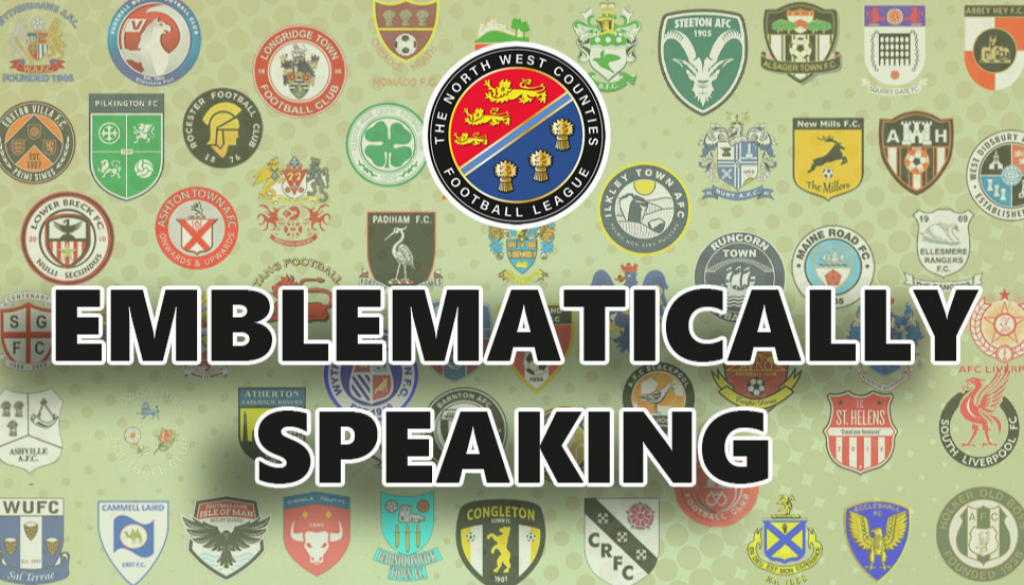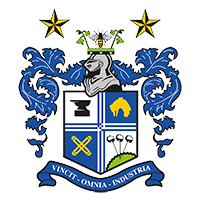
Emblematically Speaking - Bury AFC
Thu 29th December 2022 | Bury | By Martin Fallon
Amongst the most recently formed (2020) of all football clubs, the emblem of Bury AFC clearly reflects the historical origins of the club (and the town).
It is not the objective of this article to explore why the club was formed but the association with Bury FC is well known and the links to that club well understood.
Prior to 1974 and the much reviled Local Government Reorganisation Act (1972) – forgive me if I mention again that the Act came into force on April 1st of 1974 – a date with some resonance - Bury was a County Borough but is now Part of the Greater Manchester Metropolitan Borough – any comments about the proposed Greater Manchester Low Emissions Zone (currently under review) and how that would impact areas which have many rural areas are off limits – at least for the moment.
As a County Borough, Bury had a Coat of Arms – granted in 1877. This is what it looked like:
and, just to show how mind-blowingly difficult heraldic terminology can be, here is a description.
Arms : Quarterly Argent and Azure a Cross party and fretty counter-changed between an Anvil Sable in the First Quarter a Fleece Or in the Second two Shuttles in saltire threads pendent proper in the Third and three Culms of the Papyrus Plant issuing from a Mount also proper in the Fourth.
Crest : Upon a Mount a Bee volant between two Flowers of the Cotton Tree slipped all proper.
Motto: 'VINCIT OMNIA INDUSTRIA' - Industry overcomes all things
This Coat of Arms was used as the Bury FC emblem and elements of it were taken to form the Bury AFC emblem
At this point, I hand over to the creator of the Bury AFC badge Nick Hunsley – a Bury AFC fan and freelance designer - who takes us through the design elements and relates them back to the 1877 Coat of Arms.
"The four quarters have an anvil, for iron forging; a pair of crossed shuttles, for the cotton industry; and a papyrus plant for the paper trade. If I may interject here – the inventor of the Flying Shuttle was John Kay, a native of Bury - The quarters were divided by a "cross party and fretty". (The fretty is what we might call the cross-hatched bit in the very centre of the design.). Above the helm (helmet) is the crest which has a bee, symbolic of industry in general, between two cotton flowers.
"The final quarter holds the Peel Tower which looks over Bury and the surrounding area. It’s a reminder of where we’re from as we currently play in Radcliffe,
"I added the two stars to give the monument some context in the night sky. (In the 2011/12 season I added the two stars to the Bury Football Club badge for the famous FA Cup wins – which the club got approval for from the Football Association).
"I gave the foliage around the edge more flourish with clear curves and leafy forms. The badge is finished with the name and it’s year of formation. 2020 - nice and symmetrical from a designers point of view."
We will see that the charge which was in the Borough Coat of Arms (2nd - top right) described heraldically as a golden fleece has been replaced by the Peel Tower – as described by Nick - and the motto changed to positively identify the football club and the year of formation.
By way of a slight aside, we may comment that the Peel Tower – visible from many locations in Lancashire – dates back to 1852 and is a tribute to a famous son of Bury Sir Robert Peel – founder of the police force and Prime Minister from 1841 to 1846. (OK. Who thought Bury was famous only for Black Puddings?).
In the centre of the town we see a statue of Sir Robert by Edward Hodges Baily who was perhaps better known for the statue of Nelson which sits atop Nelson’s Column in London. If you go to have a look at the statue in Bury you may note that the waistcoat is fastened the wrong way round.
As a further aside, many of us will recall the old wooden rattles we used to take to football matches to “make a noise” and support our team. It is said that what we knew as the football rattle had its origins in the police force – I may expand on that in a future article (or I may not!).
We have commented often on the significance of industry to the many towns represented by football clubs in our region. As we can see, Bury is no exception. Now, hands up. Who though Bury was simply a town with a market?
For mostly obvious reasons, it can be impossible to get direct input from the individual who was the designer of a football club badge. In this case I am indebted to Nick for much of the information in this article.
 Emblematically Speaking - Bury AFC
Emblematically Speaking - Bury AFC
Thu 29th December 2022 | Bury
By Martin Fallon

Amongst the most recently formed (2020) of all football clubs, the emblem of Bury AFC clearly reflects the historical origins of the club (and the town).
It is not the objective of this article to explore why the club was formed but the association with Bury FC is well known and the links to that club well understood.
Prior to 1974 and the much reviled Local Government Reorganisation Act (1972) – forgive me if I mention again that the Act came into force on April 1st of 1974 – a date with some resonance - Bury was a County Borough but is now Part of the Greater Manchester Metropolitan Borough – any comments about the proposed Greater Manchester Low Emissions Zone (currently under review) and how that would impact areas which have many rural areas are off limits – at least for the moment.
As a County Borough, Bury had a Coat of Arms – granted in 1877. This is what it looked like:
and, just to show how mind-blowingly difficult heraldic terminology can be, here is a description.
Arms : Quarterly Argent and Azure a Cross party and fretty counter-changed between an Anvil Sable in the First Quarter a Fleece Or in the Second two Shuttles in saltire threads pendent proper in the Third and three Culms of the Papyrus Plant issuing from a Mount also proper in the Fourth.
Crest : Upon a Mount a Bee volant between two Flowers of the Cotton Tree slipped all proper.
Motto: 'VINCIT OMNIA INDUSTRIA' - Industry overcomes all things
This Coat of Arms was used as the Bury FC emblem and elements of it were taken to form the Bury AFC emblem
At this point, I hand over to the creator of the Bury AFC badge Nick Hunsley – a Bury AFC fan and freelance designer - who takes us through the design elements and relates them back to the 1877 Coat of Arms.
"The four quarters have an anvil, for iron forging; a pair of crossed shuttles, for the cotton industry; and a papyrus plant for the paper trade. If I may interject here – the inventor of the Flying Shuttle was John Kay, a native of Bury - The quarters were divided by a "cross party and fretty". (The fretty is what we might call the cross-hatched bit in the very centre of the design.). Above the helm (helmet) is the crest which has a bee, symbolic of industry in general, between two cotton flowers.
"The final quarter holds the Peel Tower which looks over Bury and the surrounding area. It’s a reminder of where we’re from as we currently play in Radcliffe,
"I added the two stars to give the monument some context in the night sky. (In the 2011/12 season I added the two stars to the Bury Football Club badge for the famous FA Cup wins – which the club got approval for from the Football Association).
"I gave the foliage around the edge more flourish with clear curves and leafy forms. The badge is finished with the name and it’s year of formation. 2020 - nice and symmetrical from a designers point of view."
We will see that the charge which was in the Borough Coat of Arms (2nd - top right) described heraldically as a golden fleece has been replaced by the Peel Tower – as described by Nick - and the motto changed to positively identify the football club and the year of formation.
By way of a slight aside, we may comment that the Peel Tower – visible from many locations in Lancashire – dates back to 1852 and is a tribute to a famous son of Bury Sir Robert Peel – founder of the police force and Prime Minister from 1841 to 1846. (OK. Who thought Bury was famous only for Black Puddings?).
In the centre of the town we see a statue of Sir Robert by Edward Hodges Baily who was perhaps better known for the statue of Nelson which sits atop Nelson’s Column in London. If you go to have a look at the statue in Bury you may note that the waistcoat is fastened the wrong way round.
As a further aside, many of us will recall the old wooden rattles we used to take to football matches to “make a noise” and support our team. It is said that what we knew as the football rattle had its origins in the police force – I may expand on that in a future article (or I may not!).
We have commented often on the significance of industry to the many towns represented by football clubs in our region. As we can see, Bury is no exception. Now, hands up. Who though Bury was simply a town with a market?
For mostly obvious reasons, it can be impossible to get direct input from the individual who was the designer of a football club badge. In this case I am indebted to Nick for much of the information in this article.


